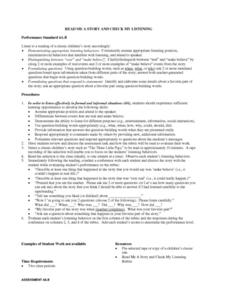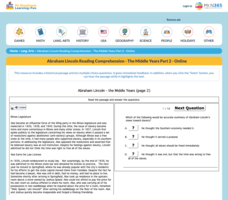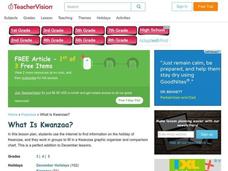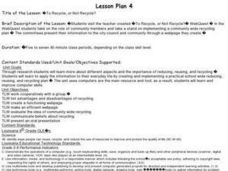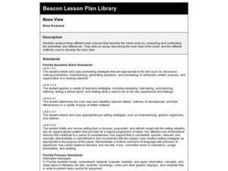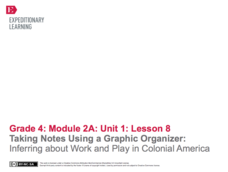Curated OER
Read Me a Story and Check My Listening
Students develop listening and reading skills with the oral reading of a story. The students demonstrate good listening skills using appropriate body language and answering assessment questions. They discuss the story looking for main...
EngageNY
Close Reading of That Book Woman: How Did People Access Books in Rural Areas of the United States?
For this ninth lesson plan in a larger beginning-of-the-year unit, close reading skills are used independently to find the gist of the story That Book Woman. Rereading for important details is the targeted skill to unlock a deeper...
University of Kansas
Newspaper in the Classroom
Newspapers aren't only for reading—they're for learning skills, too! A journalism unit provides three lessons each for primary, intermediate, and secondary grades. Lessons include objectives, materials, vocabulary, and procedure, and...
Mr. Nussbaum
Abraham Lincoln Reading Comprehension—The Middle Years (Part 2)
Abraham Lincoln's face may only be worth one cent, but the online reading passage and questions about his life are an invaluable resource. Pupils read a passage about Lincoln's experience with the Illinois Legislature, earning his law...
Curated OER
What Is Kwanzaa?
Learners use vocabulary related to Kwanzaa. They identify main ideas and details related to the celebration of Kwanzaa and summarize information about Kwanzaa. They make picture books appropriate for first and second graders.
Curated OER
Cross-Curricular Language Arts Lessons
Here are lesson ideas to begin integrating social studies content into the language arts classroom.
Curated OER
“Self Reliance” by Ralph Waldo Emerson
“Nothing is at last sacred but the integrity of your own mind.” Readers not only identify aphorisms in Emerson's "Self Reliance," but also find evidence of transcendental elements contained in the essay. They also demonstrate consistency...
EngageNY
Close Reading of Bullfrog at Magnolia Circle: Predators and Prey
Reading is fantastic, especially when it's reading about bullfrogs. Kids get cozy with predator/prey relationships as they hone their information-reading skills. They start out as they read a portion of the text aloud, then they...
EngageNY
Taking Notes Using a Graphic Organizer: Inferring About the Importance of Religion in Colonial America
Improve class understanding of colonial times by reading an informational text and filling out the accompanying graphic organizer. Class members work with a partner to read, take notes, make inferences, and synthesize information.The...
Curated OER
Finding the Main Idea and Supporting Details
Twelfth graders examine how to identify the main idea and supporting details in a reading passage. They read an article, answer who, what, when, where, and how, discuss the answers, and identify the main idea and supporting details.
Curated OER
Working with Business Letters
Learners practice with business letters. They identify main ideas and supporting details.
Curated OER
To Recycle, or Not Recycle?
To recycle or not to recycle, that is the question. Your class can find the answer by taking a teacher created WebQuest, where they assume a role of a community member taking a stand on implementing a community wide recycling plan. The...
Curated OER
Cloze Instruction And Herringbone Technique
Students sort out important information and create a visual framework for reviewing in the future. They organize a large quantity of information thus helping with learning and remembering details, cause and effect, comparison and...
Curated OER
News View
Students read and analyze three different news sources that describe the same event. They compare/contrast the similarities and differences of the news sources, and write an essay describing the main event.
Curated OER
Creating a Chapter Title
Second graders identify the main idea of a selection of text. In this creating a chapter title activity, 2nd graders discuss how to find the main idea of a chapter, listen to a chapter read aloud, and create a title with explanation.
Curated OER
Topic Sentence
Fourth graders identify the main idea of a sentence using the topic sentence and details of the paragraph. For this main idea lesson plan, 4th graders read paragraphs in the passage Hawaii Quakes, Then Shakes.
Arts Ed Washington
Art Lessons in the Classroom: Our Family
Blend art and family into one lesson with an activity involving oil pastels and watercolors. After viewing a few famous portraits of families, learners create masterpieces that represent their own families.
Curated OER
Mini-Lesson Planning for Inferences
Making inferences and drawing conclusions is a key component to successful active reading. Encourage your class to use context clues and prior knowledge to infer different elements of a story, including the setting, plot, and character...
EngageNY
Independent Reading: Building The Power of Stamina
The Incredible Book-Eating Boy is read aloud to young readers, and the story is discussed. Then, the instructional activity goes into how to build up one's reading stamina. The class brainstorms ways that they can build up their stamina...
Worksheet Web
What did it Say? – Summarizing
Provide scholars with an opportunity to practice summarizing text with a two-page learning exercise. Learners read poems, share stories with their peers, and summarize their new-found-knowledge.
University of North Carolina
Style
Just like you choose your clothes to ensure they fit the occasion, you should choose your words deliberately while writing. Style, the main topic of one handout in a series on writing skills, involves choosing words carefully and paying...
EngageNY
Taking Notes Using a Graphic Organizer: Inferring About Work and Play in Colonial America
What was life like in colonial America? Follow this lesson and your pupils will find out what people in colonial times did for work and for fun. Ask learners to compare and contrast the two texts and explain what the reading helped them...
Pennsylvania Department of Education
Analyzing Key Ideas and Details in Nonfiction
Young scholars explore nonfiction texts. In this language arts lesson, students read a nonfiction text and make predictions. Young scholars identify facts and opinions in the text and draw conclusions as they read.
Curated OER
In Search of Food...Living Off the Vegetation
Fourth graders locate information to describe what Indians gathered and how they sustained life. They use 5 resources, select a paragraph from each and state the main idea and supporting details.


